Butterflies of the Adirondacks:
Milbert's Tortoiseshell (Aglais milberti)
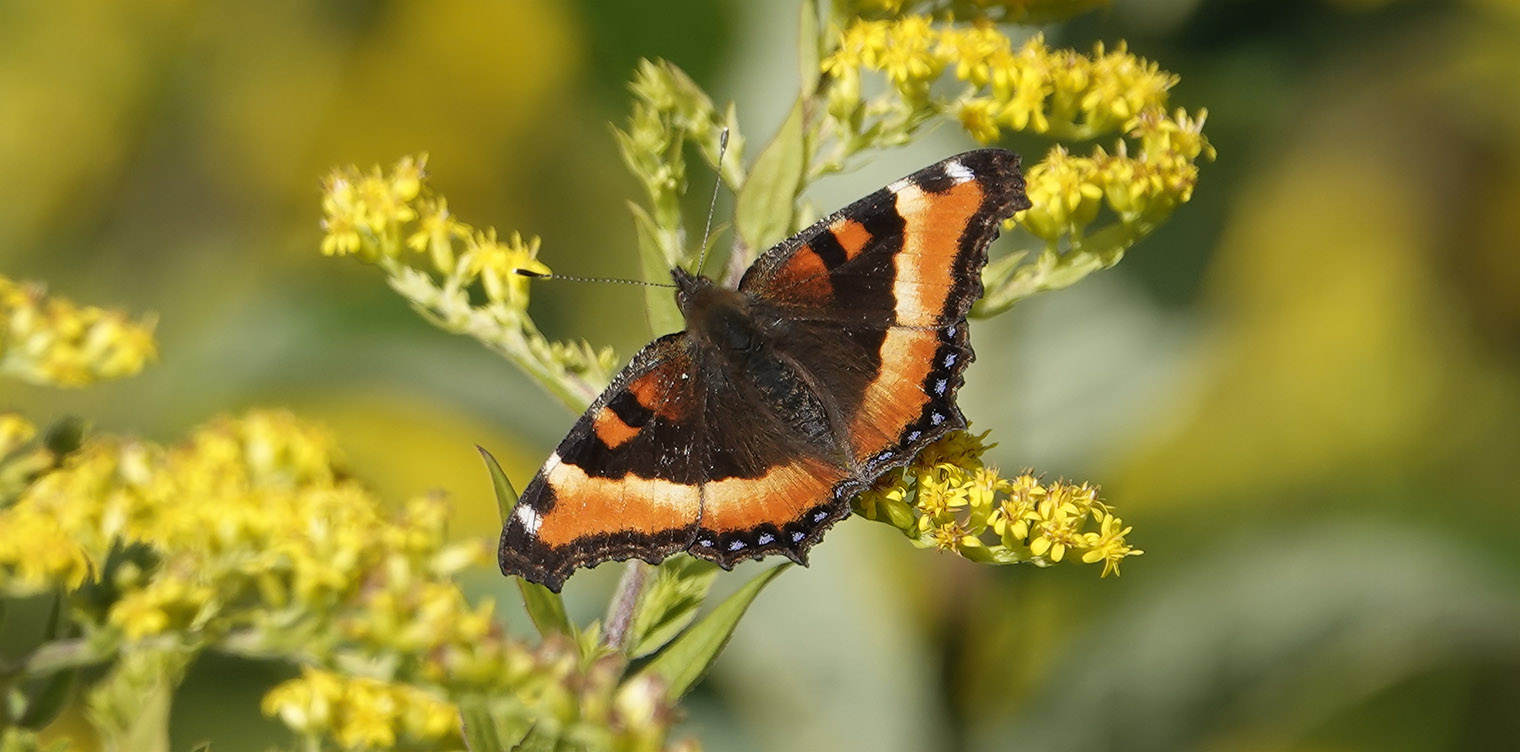
Milbert's Tortoiseshells (Aglais milberti) are medium-sized dark brown and orange butterflies that fly in the Adirondack region intermittently throughout the summer, from June through late September and very early October.
The Milbert's Tortoiseshell is a member of the Brushfoot (Nymphalidae) family, a large, diverse family of butterflies that are often some shade or orange. [1] The brushfoots derive their name from the reduced forelegs of both males and females. Brush-footed butterflies generally have large, prominent knobs on their antennae. [2] [3]
An alternate scientific name – Nymphalis milberti – is used by many sources to refer to this butterfly. [4] [5] [6 [7] [8] The Milbert's Tortoiseshell is said to be named in honor of a friend of Jean-Baptiste Godart, a 19th century French entomologist who described the species. [9] [10] Other nonscientific names include Fire-rim Tortoiseshell and Fire-Rim Tortoise Shell. [11] [12]
Milbert's Tortoiseshell: Identification
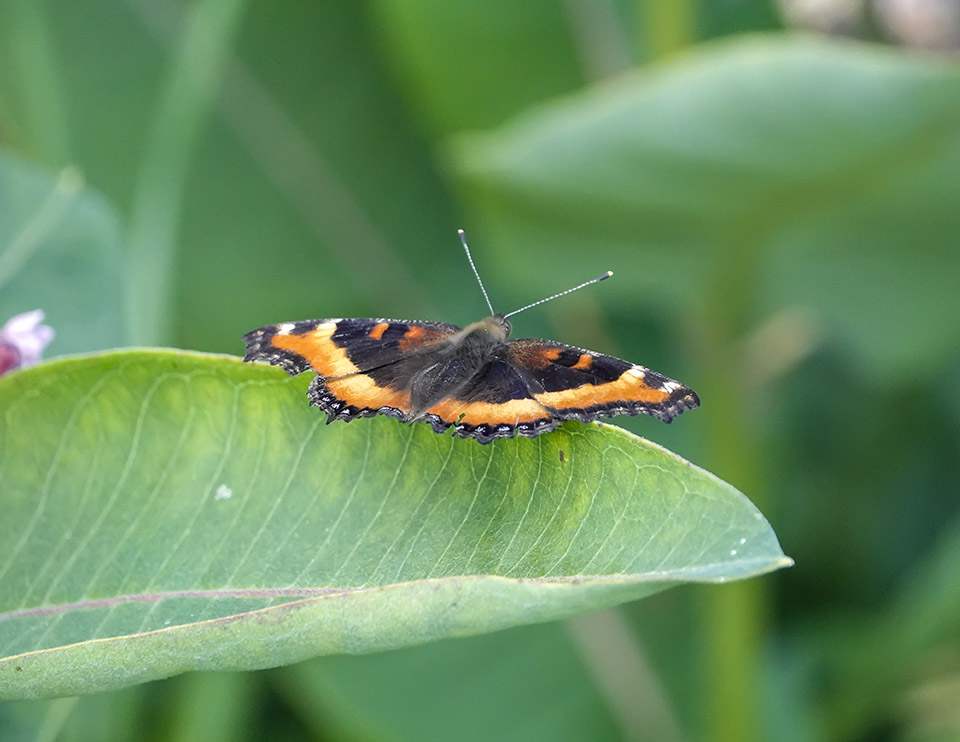
Adult Milbert's Tortoiseshells are medium-sized butterflies. With a wing span of 1⅝ to 2 inches, [13] the Milbert's Tortoiseshell is smaller than a Monarch but larger than a Cabbage White.
From above (the dorsal surfaceDorsal surface: The top side of a wing. ), the main colors to look for are orange and dark chocolate brown/black. [14]
- There is a wide orange submarginalSubmarginal: Just inside the outer margin (edge) of the wing. band on the wings, meaning that there is a band of orange just inside the outer marginMargin: The edge of the wing. (edge) of the wing. The band grades to yellow at the inner edges. [15] [16]
- Both wings are edged with a narrow black border. On the hind wing, the border may contain some chevron-shaped blue markings. [17]
- There is a very short, tail-like wing projection on the hind wing. [18] [19]
- There are two reddish-orange bars along the upper edge (costaCosta: The upper edge of both the fore wing and the hind wing.) of the fore wing, as well as single black and white markings at the fore wing tips. [20]
- The tip of the fore wing is squared off. [21]
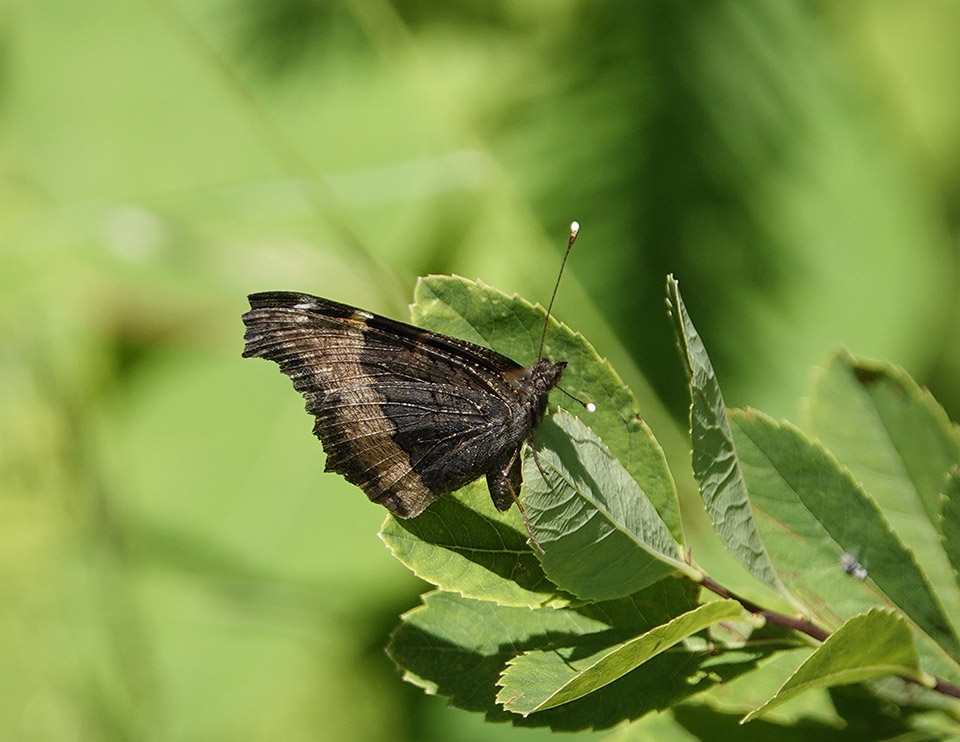
From below (the ventral surfaceVentral surface: The underside of a wing. ), the wings are dark purplish brown, with a wide tan marginal band. [22] There is a very fine blue submarginalSubmarginal: Just inside the outer margin (edge) of the wing. line at the wing edges. [23] The wing edges appear scalloped. [24]
From below, the adult Milbert's Tortoiseshell looks something like a Mourning Cloak. [25] The Mourning Cloak, however, is somewhat larger. Moreover, the band bordering the Mourning Cloak's wings is cream-yellow and much narrower than the band on the underside of the Milbert's Tortoiseshell's wings. [26] In any event, the upperside of the Mourning Cloak is almost completely dark brown with a yellowish border and looks nothing like the upperside of the Milbert's Tortoiseshell.
The eggs of the Milbert's Tortoiseshell are pale green. [27] They are shaped like a barrel with vertical ribs. [28]
The mature caterpillar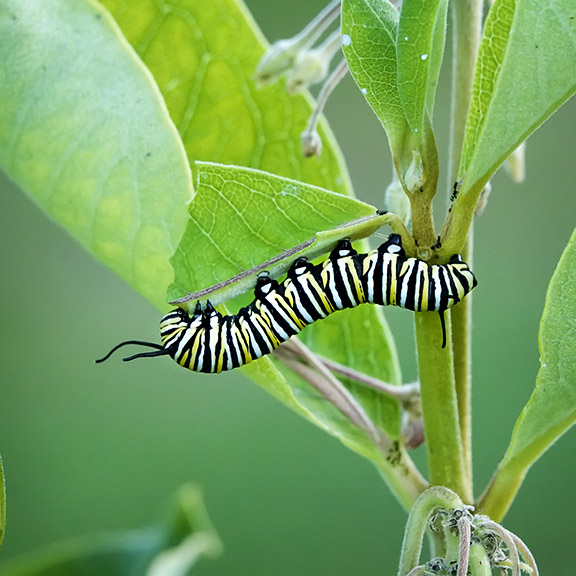 Caterpillar: Butterflies and moths develop through a process called metamorphosis, which entails four states: eggs, caterpillar (larva), pupa, and adult. The caterpillar, representing the second state in the life cycle, hatches from the egg. Its primary activity is eating. The caterpillars first eats its eggshell and then begins consuming the leaves on which the egg was laid. Newly-born caterpillars are very small and expand as they start growing. Because the exoskeleton does not stretch, the caterpillar grows by molting (shedding its skin). The stages between larval molts are called instars. (larva) is black and spiny. [29] It is heavily speckled with white and has a broken yellow lateral line along each side. [30] The body is pale below. [31]
Caterpillar: Butterflies and moths develop through a process called metamorphosis, which entails four states: eggs, caterpillar (larva), pupa, and adult. The caterpillar, representing the second state in the life cycle, hatches from the egg. Its primary activity is eating. The caterpillars first eats its eggshell and then begins consuming the leaves on which the egg was laid. Newly-born caterpillars are very small and expand as they start growing. Because the exoskeleton does not stretch, the caterpillar grows by molting (shedding its skin). The stages between larval molts are called instars. (larva) is black and spiny. [29] It is heavily speckled with white and has a broken yellow lateral line along each side. [30] The body is pale below. [31]
The chrysalisChrysalis: The hard outer shell of a pupa. of the Milbert's Tortoiseshell is somewhat variable in appearance. It is either gray or pale golden green with dark brown flecks. [32]
Milbert's Tortoiseshell: Life History
Female Milbert's Tortoiseshells lay eggs in large clusters on the undersides of host plant leaves, usually on the upper half of the plant. [33] [34] [35] The host plants used are nettles (Urtica), including the European Stinging Nettle (Urtica dioica) a plant native to Europe, temperate Asia and Western North Africa, but widely distributed in the US and Canada. [36] [37] It grows vigorously in disturbed soils, out-competing native nettle species. Milbert's Tortoiseshells, like Red Admirals, have adopted it as a host plant, supplementing native Urtica species. [38]
Young caterpillars Caterpillar: Butterflies and moths develop through a process called metamorphosis, which entails four states: eggs, caterpillar (larva), pupa, and adult. The caterpillar, representing the second state in the life cycle, hatches from the egg. Its primary activity is eating. The caterpillars first eats its eggshell and then begins consuming the leaves on which the egg was laid. Newly-born caterpillars are very small and expand as they start growing. Because the exoskeleton does not stretch, the caterpillar grows by molting (shedding its skin). The stages between larval molts are called instars. feed together on the upper surfaces of the leaf in a silken nest near the top of the host plant. [39] They gradually work their way downward, descending leaf by leaf. [40] Older caterpillars feed alone and rest in shelters made of a folded leaf. [41] [42] [43] [44]
Caterpillar: Butterflies and moths develop through a process called metamorphosis, which entails four states: eggs, caterpillar (larva), pupa, and adult. The caterpillar, representing the second state in the life cycle, hatches from the egg. Its primary activity is eating. The caterpillars first eats its eggshell and then begins consuming the leaves on which the egg was laid. Newly-born caterpillars are very small and expand as they start growing. Because the exoskeleton does not stretch, the caterpillar grows by molting (shedding its skin). The stages between larval molts are called instars. feed together on the upper surfaces of the leaf in a silken nest near the top of the host plant. [39] They gradually work their way downward, descending leaf by leaf. [40] Older caterpillars feed alone and rest in shelters made of a folded leaf. [41] [42] [43] [44]
Adults are said to feed primarily on sap, rotting fruit, and animal dung. [45] They are also seen nectaring on a variety of flowers, including goldenrods, lilacs, Spreading Dogbane, Swamp Milkweed, Common Milkweed, Joe Pye Weed, Common Hawkweed, Black-eyed Susan, Red Clover, and Common Dandelion. [46] [47] [48]
Milbert's Tortoiseshells reportedly overwinter as adults in sheds, woodpiles, or under bark, sometimes in small groups. [49] [50] [51] [52] Some sources suggest that some adults in the last brood hibernate, while a portion of the final brood overwinters as chrysalidsChrysalid: Refers to being in the pupa stage, enclosed in a cocoon, before turning into a butterfly or moth.. [53] [54] [55]
The Milbert's Tortoiseshell is a strong flyer, flitting rapidly about its territory. [56] [57] It regularly alights on the ground or on a rock or tree, where it can be seen basking with its wings spread flat. [58] [59]
Milbert's Tortoiseshell: Habitat and Range
The range of Milbert's Tortoiseshells extend from southern Alaska east to Newfoundland and West Virginia and south to California, Nevada, and New Mexico. [60] Their range includes all of the western US and the northeastern US, as well as the Canadian provinces south of the tundra. [61]
Milbert's Tortoiseshells are said to be medium specialists, meaning that they are seen in a variety of habitats, but are limited by the presence of appropriate host plants and tolerance for climate. [62] They can be found in moist pastures and fields, marshes, woodland trails, streamsides, and wet areas adjacent to woodlands. [63] [64]
Milbert's Tortoiseshell: Flight
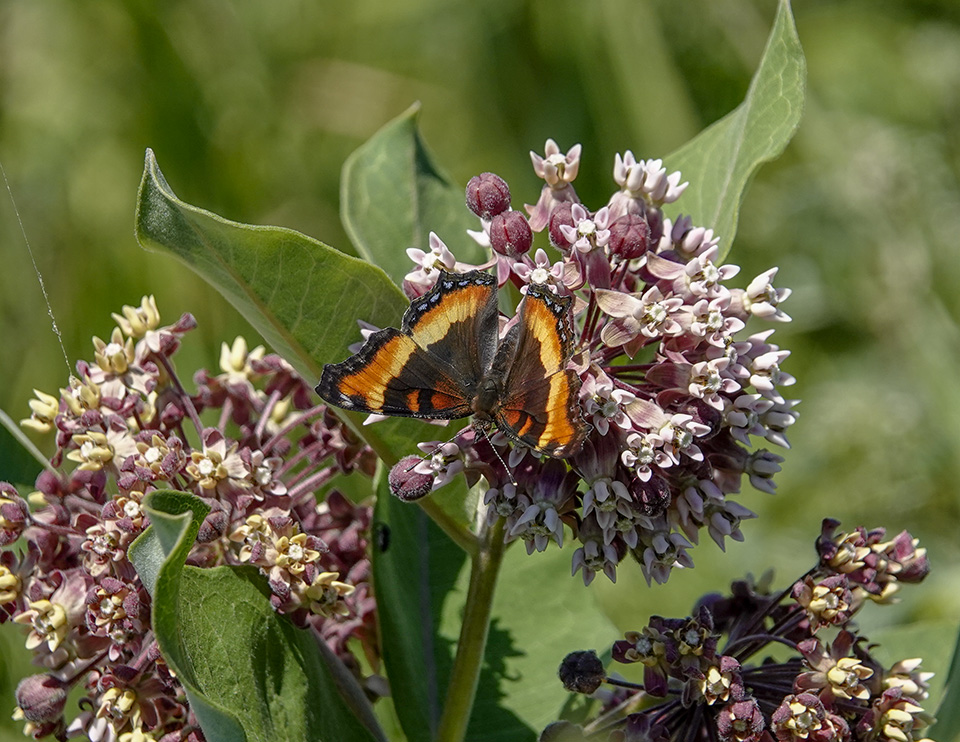
The flight period of Milbert's Tortoiseshells, as with all butterflies, varies with region and probably shifts from year to year. Throughout its range, the Milbert's Tortoiseshell is said to have two or possibly three broodsBrood: A single generation of butterflies, hatched from the eggs laid by females of the previous generation. Members of a brood fly during roughly the same time period., flying from May through October. [65] [66] [67]
- In Wisconsin, Milbert's Tortoiseshells reportedly have two or more broods and may be found from early March through October.[68]
- The flight period in Massachusetts is from early March to late October, with two or three broods. The first brood flies from mid-June to late July, the second from late July to early September. A portion of this second brood's offspring emerges in September, flying during the fall and then hibernating. Another portion of the second brood's offspring pupatesPupate: to transform from a caterpillar to a chrysalis. in the fall, then emerges and flies the following spring from March to late May. [69] [70]
- In Vermont, Milbert's Tortoiseshells reportedly have two broods, with a summer brood flying in June and July and a fall brood flying from the beginning of August. [71]
- In Montana, there is one flight in the northern areas and at higher elevations, flying mostly in late July. Lower elevations and the eastern parts of the state have two flights, from late June to early August, and late August overwintering to May. [72]
- In Canada, the Milbert's Tortoiseshell is said to fly from April to October, with possibly three overlapping generations. [73]
The flight period and abundance of the Milbert's Tortoiseshell within the Adirondack Park can only be roughly estimated, based mainly on a very limited number of verified sightings on Butterflies and Moths of North America (BAMONA) and reported observations on iNaturalist.
- The advantage of iNaturalist is that it is a popular citizen science web site that attracts many observers, in part because it covers both plants and animals (making it easy for people to record all of their observations in one place) and in part because the process of submitting an observation is very easy. The disadvantage is that an individual observation can achieve "research-grade" status by having the identification confirmed by the observer and one additional individual, who may or may not have expertise in that particular taxon.
- The advantage of BAMONA is that sightings are verified by regional specialists who are recognized experts. The disadvantage is that there are fewer sighting records for most species, partly because the site covers only butterflies and moths and partly because the process of submitting a sighting is more time-consuming.
- Both data sets share a common problem of citizen science: reported trends may reflect trends in the number of observers and their willingness to submit reports, not the abundance of the butterfly in question.
With these caveats in mind, it appears that Milbert's Tortoiseshells fly in the Adirondack region intermittently throughout the summer, from June through late September and very early October.
- Milbert's Tortoiseshell have been rare guests at the Paul Smith's College VIC Native Species Butterfly House, which collects its butterfly and moth residents from the immediate area. [74] In 2012, this species was recorded only two times, in late June. In 2015, the species was recorded six times, in late August. The species was not recorded in 2013 of 2016. The 2014 logbook and later logbooks were not available.
- BAMONA lists 79 verified sightings of Milbert's Tortoiseshells in New York State, but only 7 in the 12 counties with territory that falls within the Adirondack Park. The Adirondack sightings were in late June, late July, and throughout September. [75]
- There have been 18 research-grade observations of adult Milbert's Tortoiseshells within the Adirondack Park Blue Line in iNaturalist. [76] This compares to the 240 research-grade observations within the Adirondack Park for the most popular and abundant butterfly: the Monarch. The observations for the Milbert's Tortoiseshell extend from late June to late summer and early fall. There were two observations in 2016, both in late June. [77] There was only one observation in 2017, in early October. [78] There were four observations in 2018, in late June, late July, and early August. [79] In 2019, there were eight observations, in mid-July, early August, and early September. [80]
References
- Susan Grimm Hanley. Interpretive Naturalist, Paul Smith's College Native Species Butterfly House. Species Logbooks.
- Butterflies and Moths of North American. Species Profiles. Milbert's Tortoiseshell. Aglais milberti. Retrieved 27 November 2019.
- Butterflies and Moths of North American. Sighting Records. Milbert's Tortoiseshell. Aglais milberti. Retrieved 28 November 2019.
- iNaturalist. Adirondack Park Sightings. Milbert's Tortoiseshell. Aglais milberti. Retrieved 28 November 2019.
- iNaturalist. Adirondack Park Sightings 2016. Milbert's Tortoiseshell. Aglais milberti. Retrieved 28 November 2019.
- iNaturalist. Adirondack Park Sightings 2017. Milbert's Tortoiseshell. Aglais milberti. Retrieved 28 November 2019.
- iNaturalist. Adirondack Park Sightings 2018. Milbert's Tortoiseshell. Aglais milberti. Retrieved 28 November 2019.
- iNaturalist. Adirondack Park Sightings 2019. Milbert's Tortoiseshell. Aglais milberti. Retrieved 28 November 2019.
- Massachusetts Butterfly Club. Massachusetts Butterfly Species List. Milbert's Tortoiseshell. Nymphalis milberti. Retrieved 28 November 2019.
- Massachusetts Audubon. Butterfly Atlas Species Accounts. Milbert's Tortoiseshell. Nymphalis milberti. Retrieved 28 November 2019.
- The Butterflies of Massachusetts. Milbert’s Tortoiseshell. Aglais milberti. Retrieved 28 November 2019.
- McFarland, Kent P. and Bryan Pfeiffer. Vermont Butterfly Survey. Vermont Center for Ecostudies – Vermont Atlas of Life. Milbert's Tortoiseshell. Aglais milberti. Retrieved 28 November 2019.
- Integrated Taxonomic Information System. Aglais milberti. Retrieved 28 November 2019.
- Iowa State University. Department of Entomology. BugGuide. Aglais milberti. Retrieved 28 November 2019.
- Wisconsin Butterflies. Milbert’s Tortoiseshell. Nymphalis milberti. Retrieved 28 November 2019.
- Montana Field Guides. Milbert's Tortoiseshell. Aglais milberti. Retrieved 28 November 2019.
- Ross Layberry, Peter Hall, and Don Lafontaine. The Butterflies of Canada (University of Toronto Press, 1998), p. 204, Plate 17, Plate 27.
- Thomas J. Allen, Jim P. Brock, James P. Brock, Jeffrey Glassberg. Caterpillars in the Field and Garden: A Field Guide to the Butterfly Caterpillars of North America (Oxford University Press, 2005), pp.96-97.
- David L. Wagner. Caterpillars of Eastern North America: A Guide to Identification and Natural History (Princeton University Press, 2010), p. 116.
- National Audubon Society. Field Guide to Butterflies (New York: Alfred A. Knopf, 1981), pp. 537-538, 622-623, Plate 658. Retrieved 29 November 2019.
- Jeffrey Glassberg. Butterflies of North America (Sterling Publishing Company, 2011), pp. 145-146.
- Jeffrey Glassberg. Butterflies through Binoculars. The East. A Field Guide to the Butterflies of Eastern North America (Oxford University Press, 1999), pp. 100, 121-122, Plate 35.
- Jeffrey Glassberg. A Swift Guide to Butterflies of North America. Second Edition. (Princeton University Press, 2017), pp. 224.
- Jim P. Brock and Kenn Kaufman. Kaufman Field Guide to Butterflies of North America (Houghton Mifflin, 2003), pp. 200-201.
- Paul A. Opler. A Field Guide to Eastern Butterflies (The Peterson Field Guide Series, Houghton Mifflin Company, 1992,1998), pp. 50-51, 88-89, 268-269. Retrieved 29 November 2019.
- James A. Scott. The Butterflies of North America. A Natural History and Field Guide (Stanford University Press, 1986), pp. 134-135, 289, Plate 17. Retrieved 29 November 2019.
- Donald and Lillian Stokes. Stokes Butterfly Book. The Complete Guide to Butterfly Gardening, Identification, and Behavior (Little, Brown and Company, 1991), pp. 68-71.
- Paul A. Opler and George O. Krizek. Butterflies East of the Great Plains: An Illustrated Natural History (The Johns Hopkins University Press, 1984), pp. 157-158, Plate 29.
- Rick Cech and Guy Tudor. Butterflies of the East Coast. An Observer's Guide (Princeton University Press, 2005), p. 188.
- Timothy L. McCabe. Atlas of Adirondack Caterpillars. With a Host List, Rearing Notes and a Selected Bibliography of Works Depicting Caterpillars. (New York State Museum Bulletin No. 470, 1991), p. 4. Retrieved 22 February 2017.
